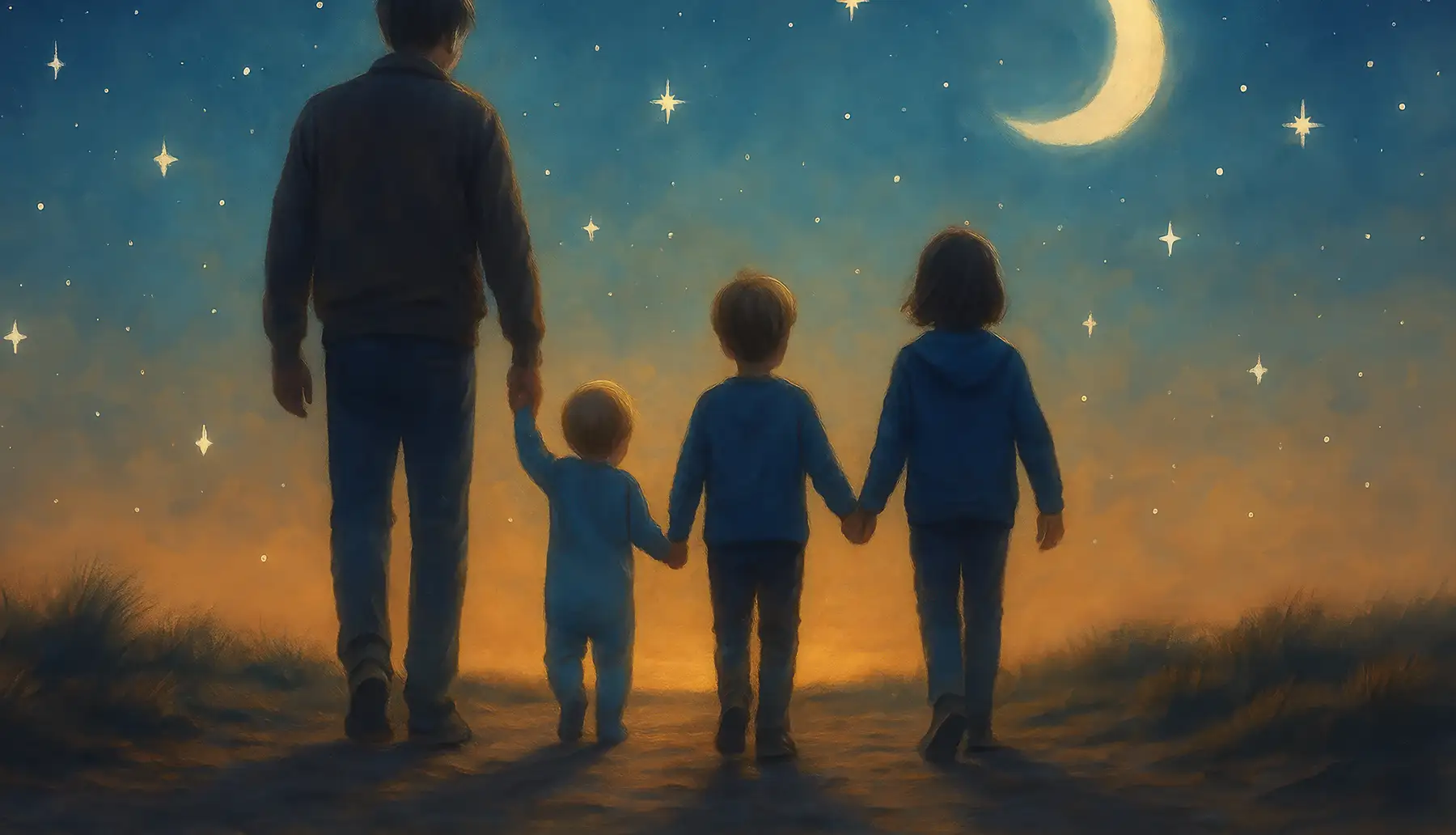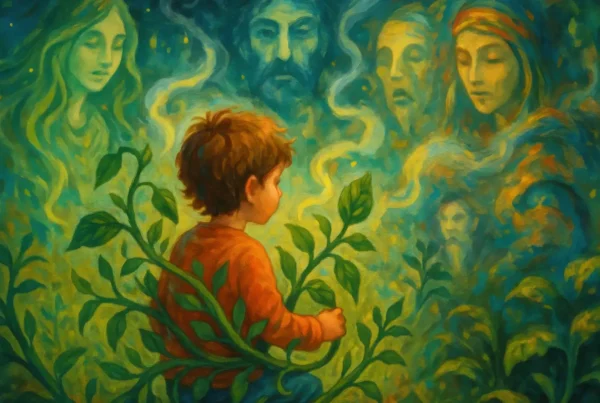BOOK YOUR WORKSHOP TODAY
All posts published here are presented as casual conversation pieces to provoke thought in some direction or another, they do not necessarily represent fixed opinions of the Inner Council, as our work exists beyond the spectrum of bound statement and singular clause.
Listen to this article | More articles with audio
Why remembering the early structures of consciousness changes everything about how we relate, parent, teach, and heal.
Key Takeaways
- Children inhabit earlier structures of consciousness that adults have forgotten.
- Behaviour that appears irrational is developmentally appropriate when seen through Gebser’s model.
- Empathy grows when adults respond to a child from the structure they are using, not from adult logic.
- Understanding these structures supports both parenting and inner child healing.
- Meaning-making emerges in layers: sensation → magical participation → story → logic.
Why We Misunderstand Children
Adults often believe they understand children because they once were children. But memory is a fragile narrator. We remember facts, events, maybe a handful of feelings, but we don’t remember what consciousness felt like when it was still forming. We don’t recall the way our earliest experiences flooded our senses, or how meaning emerged before language and logic existed.
So we project adult consciousness onto children.
- We expect rationality where there is only sensation.
- We expect emotional regulation where there is only instinct.
- We expect perspective-taking where there is only immediacy.
- We expect self-reflection where there is only experience.
This gap, between what adults expect and what children are actually capable of, is the source of most relational misunderstandings.
Jean Gebser’s model of consciousness offers something we rarely get in Western child development frameworks: a map of how consciousness feels from the inside. Not just what children can “do,” but how they experience reality, how they build meaning, and why their behaviour is coherent even when it appears irrational. Understanding this map allows adults to approach children with deeper empathy because it reminds us that children inhabit layers of consciousness we have forgotten—or layered over—in adulthood.
Children Don’t Think Like Adults — They Think Like Earlier Humanity

Gebser described four primary structures of consciousness: archaic, magic, mythic, and mental. Each one represents a way of perceiving, relating, imagining, and organising reality. What is astonishing, and deeply practical, is that these structures reappear in early childhood development:
- Infancy echoes the archaic
- Toddlerhood echoes the magic
- Early childhood echoes the mythic
- Middle childhood echoes the mental
This means children are not “immature adults.” They are beings moving through the same layers of consciousness that shaped early humanity.
A toddler seeing a shadow on the wall and believing it’s alive is not misunderstanding the world, they are perceiving through the magic structure, where reality is fluid, animated, and relational. A six-year-old insisting that the moon is following her is not being silly, she is perceiving the world through the mythic structure, where symbolic meaning carries more weight than physical laws. A ten-year-old who becomes obsessed with fairness is not being dramatic, they are stabilising the mental structure, where logic, order, and “rules of reality” crystallise.
When adults recognise these structures, something shifts. We stop expecting children to be something they cannot be. We stop interpreting developmentally normal behaviour as defiance, regression, or irrationality. We begin to speak to them in the language of the structure they’re actually inhabiting. This is the foundation of empathy.
Why Adults Misinterpret Children (and How Gebser Corrects This)
The most common relational difficulty between adults and children is not behavioural, it is perceptual. Adults assume the child is seeing the same world they are. But a child in the archaic, magic, or mythic structure isn’t just thinking differently, they are inhabiting a different reality. Here are the most common ways adults misinterpret children, and how Gebser helps reframe them:
Adults expect rationality (mental structure) from a child who is still primarily magic or mythic.
A toddler terrified of thunder may believe their fear caused the storm.
Adults see irrationality; Gebser sees developmental coherence.
Adults confuse symbolic truth with literal falsehood.
A child who says “my heart hurts” is not lying about a physical injury; they are describing emotional meaning through a mythic-symbolic frame.
Adults assume children manipulate when they are actually overwhelmed.
When a child screams, cries, clings, or falls apart they are in the archaic or magic structure. Where the nervous system has no autonomous regulation.
Adults interpret imaginative statements as dishonesty.
In the mythic structure, imagination is truth. The child isn’t lying, they’re using story to organise emotion.
Adults introduce logic where empathy is required.
Trying to explain bedtime fears rationally to a child still in the magic structure is like offering math to someone who needs comfort.
Gebser’s model corrects all of this.
It teaches adults that meaning arises differently at each structure, and that the child is always communicating truth, just not always in the language of adulthood.
“The structures of consciousness through which humanity has evolved are the very same layers each individual child passes through.” – Jean Gebser
Using Gebser’s Model to Create Emotional Safety
Once we understand the structure a child is in, we can finally respond in a way that makes them feel seen. Here’s how each structure invites a different kind of empathy:
Archaic (0–6 months, or deep overwhelm in any age)
Need: presence, safety, co-regulation
- Hold them
- Reduce stimulation
- Slow your rhythm
- Offer warmth and grounding
This structure cannot use words.
Safety is the only language it understands.
Magic (6 months–3 years, or emotional flooding)
Need: rhythm, mirroring, predictability
- Simple repetition
- Rituals and routines
- Comfort objects
- A steady, calm tone
- Let them borrow your regulation
Magic understands feeling, not explanation.
Mythic (3–7 years, imagination/dream logic)
Need: story, metaphor, connection through meaning
- Speak symbolically
- Draw with them
- Use stories to explain big feelings
- Let imagination be the bridge
Mythic consciousness learns through narrative, not argument.
Mental (7–12+ years, logic and exploration)
Need: clarity, fairness, dialogue
- Explain consequences
- Offer choices
- Invite collaboration
- Use step-by-step reasoning
The mental structure needs understanding, not control.
By matching the intervention to the structure, adults stop overwhelming or confusing children,
and instead offer exactly what each developmental layer requires to feel safe. The child begins to trust. And when trust forms, behaviour stabilises. Empathy becomes natural.
Why This Matters for Inner Child Work and Adult Healing
Gebser’s model is not just useful for relating to children, it is a map for understanding the child within us.
Every adult contains all four structures:
- We regress to archaic in panic
- We slip into magic when catastrophising
- We return to mythic when telling emotional stories
- We rise into mental when problem-solving
When adults try to “heal” by staying purely in the mental structure (logic, analysis, explanation), they unintentionally ignore the younger structures where the wound actually lives. This is why adults often feel stuck despite insight. They are speaking adult language to a child-level injury. Gebser helps adults locate themselves, and recognise when their inner child is speaking from an archaic, magic, or mythic layer.
Healing happens when:
- The archaic part is given safety
- The magic part is given rhythm and attunement
- The mythic part is given story and symbolic expression
- The mental part is invited to integrate, not dominate
Empathy becomes possible not only toward children, but toward the younger selves we carry inside. This is the doorway to genuine inner child work:
We learn to speak to the inner child in the language she understands.
Not the language we prefer.
Seeing Through the Eyes of the Child Again
Understanding Gebser brings us back to a truth adults often forget: children are not irrational, immature, or dramatic. They are simply living in an earlier, more fluid, more symbolic structure of consciousness.
When we meet them in that structure:
- behaviour makes sense
- emotional expression becomes coherent
- trust grows
- and the child feels seen
When we don’t, the child feels misunderstood, overwhelmed, or shamed for something developmentally normal. Empathy begins when adults stop asking children to think like grown-ups and instead remember how consciousness grows, from sensation to magic, from magic to story, from story to thought.
And perhaps most importantly: When we learn to relate to real children, we learn how to relate to our own inner child. This is the foundation of healing, the essence of reparenting and the heart of Inner Council work.
Please download our Developmental Summary for Practitioners and Educators document on Jean Gebser’s Stages of Childhood Meaning-Making.
And visit our Inner Child Workshop page for more information.
Further Insights & Inner Frameworks
Non-rational Vs Irrational
Children and our inner child parts are non-rational, not irrational. “Non-rational” simply means they do not operate using adult cognitive processes like logic, abstraction, or linear cause-and-effect thinking. Instead, they interpret the world through emotion, sensation, intuition, attachment needs, and early implicit memories. Their responses arise from a developmental mode of knowing shaped by safety, connection, and lived experience, not by reasoning. In this sense, the child’s reactions are coherent, appropriate, and meaningful within the child’s emotional reality.
“Irrational,” by contrast, is a judgment—it implies something is wrong, faulty, or unreasonable. When we label a child’s emotional response (inner or outer) as “irrational,” we apply adult standards to a developmental state that simply functions differently. This creates shame, suppression, and disconnection from genuine needs. Recognising the child as non-rational preserves dignity: it allows us to meet the child’s world with understanding rather than correction, and to offer the containment and compassion that help emotional truth become integrated rather than rejected.
Suggested Reading
- Jean Gebser – The Ever-Present Origin
- The foundational text on the four (and later, integral) structures of consciousness. Dense but transformative.
- Ken Wilber – The Spectrum of Consciousness
- A clear, integrative expansion of Gebser’s framework, linking stages of development with psychological healing.
- Jean Piaget – The Origins of Intelligence in Children
- Cognitive development explained from a scientific perspective; aligns closely with the magic and mythic structures.





